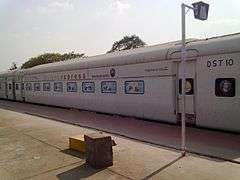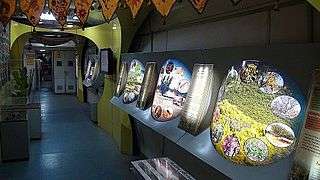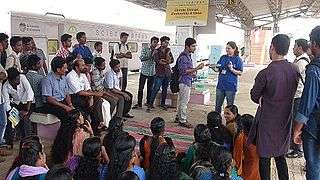Science Express
The Science Express is a mobile scientific exhibition for children mounted on a train which travels across India. The project was launched on 30 October 2007 at the Safdarjung railway station, Delhi by the Department of Science and Technology (DST), Government of India. Although open for all, the project primarily targets students and teachers. As of 2017, the train has had nine phases and has showcased exhibitions on three themes. The first four phases from 2007 to 2011 were called "Science Express" and were focused on micro and macro cosmos. The next three phases from 2012 to 2014 remodelled the exhibits as "Biodiversity Special". The eighth and ninth phase from 2015 to 2017 was redesigned to focus on "Climate Change".
Collaborations and exhibits
The project was initiated by the Department of Science and Technology (DST) in 2007 primarily focusing for students and teachers and has no entry fee. DST focused the first four phases on micro and macro cosmos and highlighted the developing newer researches being done in the fields of science and technology worldwide. It covered topics like the Big Bang, building blocks of life, genes, senses, and universe.[1]
The second theme focused on biodiversity within India and was modeled jointly by DST and Ministry of Environment, Forest and Climate Change (MoEFCC). It covered the diverse aspects of life in Trans-Himalayan and the Himalayan regions, the Gangetic Plains, the North Easterns hilly areas, the deserts, the coastal Western Ghats, the Deccan Plateau, and various islands. A "Kids Zone" was also introduced for fun activities like puzzles and games related to science.[2]
The third theme was designed for Climate Change and was developed as collaborative work between DST, MoEFCC, Department of Biotechnology (DBT), Ministry of Railways, Vikram A Sarabhai Community Science Centre (VASCSC) and Wildlife Institute of India (WII). The ninth phase of the exhibition had 16 coaches of which eight were developed by MoEFCC.[3] Solar panels have been installed on rooftop of some coaches and facilities to train teachers is also available.[4] A team from the VASCSC, which manages the entire exhibit, guides students through the exhibition and also engages into activities on the railway platform.[5] Dilip Sarkar, executive director of VASCSC said that the exhibit aims to "transform the vehicle into a people's movement and motivate them to take individual actions to fight climate change".[6]
The exhibition while in its eighth phase had travelled for 142,000 kilometres (88,000 mi) and halted at 455 stations together. In over 1,600 days for which it has been exhibited it has been visited by nearly 1.5 crore (15 million) people with students from over 33,800 schools.[4] The exhibition thus hold record of being the largest, the longest running and the most visited exhibition as noted in the Limca Book of Records.[3][7]
Statistics
| Theme | Phase | Duration | Approx. distance covered | Halts | Ref. |
|---|---|---|---|---|---|
| Science Express | 1 | 30 Oct 2007 – 4 June 2008 | 15,000 kilometres (9,300 mi) | 57 | [8] |
| 2 | 30 Nov 2008 – 30 May 2009 | 17,000 kilometres (11,000 mi) | 51 | [8][9][10] | |
| 3 | 02 Oct 2009 – 27 Apr 2010 | 18,000 kilometres (11,000 mi) | 56 | [8][11][12] | |
| 4 | 04 Dec 2010 – 16 Jun 2011 | 18,000 kilometres (11,000 mi) | 57 | [8][13] | |
| Biodiversity Special | 5 | 5 Jun 2012 – 13 Jan 2013 | 18,000 kilometres (11,000 mi) | 52 | [8][14] |
| 6 | 9 Apr 2013 – 28 Oct 2013 | 19,000 kilometres (12,000 mi) | 62 | [8][15] | |
| 7 | 28 Jul 2014 – 06 Feb 2015 | 17,000 kilometres (11,000 mi) | 56 | [8][16] | |
| Climate Change | 8 | 15 Oct 2015 – 07 May 2016 | 19,800 kilometres (12,300 mi) | 64 | [8][1] |
| 9 | 17 Feb 2017 – 8 Sep 2017 | 19,000 kilometres (12,000 mi) | 74 | [1][17] |
Gallery
- Science Express

 Students queue outside the train in 2014
Students queue outside the train in 2014- Interior of the exhibition in 2011
 Exhibits of the Biodiversity Special in 2014
Exhibits of the Biodiversity Special in 2014 Activities conducted on the railway platform for the visitors
Activities conducted on the railway platform for the visitors
References
- "Science Express Climate Action Special". ScienceExpress.in. 2017. Retrieved 15 June 2017.
- Tiwari, Sudhir (9 April 2013). "Science Express: Biodiversity Special". Press Information Bureau. Retrieved 15 June 2017.
- "Ninth Phase of Science Express to Criss-Cross India till September this Year Curtain Raiser". Press Information Bureau. 14 February 2017. Retrieved 15 June 2017.
- "'Science Express Should Reach Out to more than Six Lakh Villages of The Country': Anil Madhav Dave". Press Information Bureau. 17 February 2017. Retrieved 15 June 2017.
- "Science Express: A School on Wheels is Coming to a Railway Station Near You". National Geographic Traveller. 22 February 2017. Retrieved 15 June 2017.
- "Science Express to remain open for all today, tomorrow". The Times of India. Patna. 1 April 2017. Retrieved 15 June 2017.
- "Dedicated to climate-change, the Science Express flagged". Economic Times. 19 February 2017. Retrieved 15 June 2017.
- "Tour Phase I-VIII". ScienceExpress.in. 7 May 2016. Retrieved 17 June 2017.
- "Science Express 30 November 2008 to 30 May 2009". ScienceExpress.in. 2009. Retrieved 15 June 2017.
- "Science Express II tour". ScienceExpress.in. 2009. Retrieved 15 June 2017.
- "Science Express 2 October 2009 to 27 April 2010". ScienceExpress.in. 2009. Retrieved 15 June 2017.
- "Science Express III tour". ScienceExpress.in. 2009. Retrieved 15 June 2017.
- "Science Express: Shaping the Future" (PDF). ScienceExpress.in. 2010. Retrieved 15 June 2017.
- "Science Express: Biodiversity Special" (PDF). ScienceExpress.in. 2012. Retrieved 15 June 2017.
- "Science Express VI: Biodiversity Special" (PDF). ScienceExpress.in. 2013. Retrieved 15 June 2017.
- "Science Express VII: Biodiversity Special" (PDF). ScienceExpress.in. 2013. Retrieved 15 June 2017.
- "Route Map". ScienceExpress.in. Retrieved 17 June 2017.